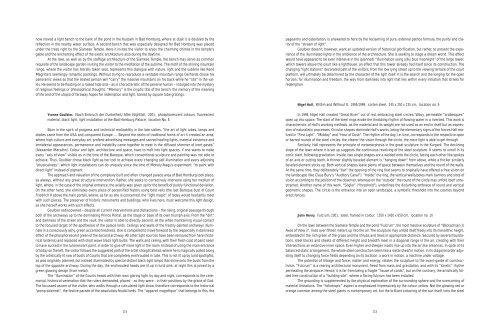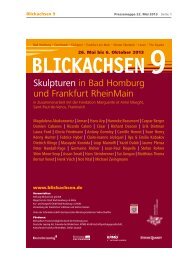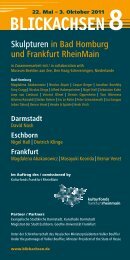Edition Scheffel - Blickachsen
Edition Scheffel - Blickachsen
Edition Scheffel - Blickachsen
Erfolgreiche ePaper selbst erstellen
Machen Sie aus Ihren PDF Publikationen ein blätterbares Flipbook mit unserer einzigartigen Google optimierten e-Paper Software.
now moved a light bench to the bank of the pond in the Kurpark in Bad Homburg, where at dusk it is doubled by the<br />
reflection in the nearby water surface. A second bench that was especially designed for Bad Homburg was placed<br />
under the trees right by the Siamese Temple. Here it invites the visitor to enjoy the charming chimes in the temple's<br />
gable and the enchanting effect of the exotic architecture also during the daytime.<br />
At the lake, as well as by the staffage architecture of the Siamese Temple, the bench may serve as common<br />
requisite of the landscape garden inviting the visitor to the meditation of the sublime. The motif of the shining mountain<br />
range, where the visitor has literally taken seat, represents this dialogue with nature, light and the sublime like René<br />
Magritte's seemingly romantic paintings. Without trying to reproduce a veritable mountain range Gerhards chose his<br />
panoramic views so that the seated person will “carry“ the massive mountains on his back while he “sits“ in the valley.<br />
He seems to be floating on a raised hide and – as is characteristic of the pensive human – indulged into the mystery<br />
of religious feelings or philosophical thoughts. “Memory“ is the cryptic title of the bench, the memory of the meaning<br />
of life and of the utopia of faraway hopes for redemption and light, barred by square tube gratings.<br />
Yvonne Goulbier, Nach Einbruch der Dunkelheit/ After Nightfall, 2001, phosphorescent colours, fluorescent<br />
material, black light, light installation at the Bad Homburg Palace, location No. 8<br />
Born in the spirit of progress and technical realizability in the late sixties, “the art of light tubes, lamps and<br />
diodes came from the USA and conquered Europe … Beyond the realm of traditional forms of art it created an area,<br />
where high culture and everyday art, profane advertising messages and sacred healing lights, material existence and<br />
immaterial appearances, permanence and instability came together to meet in the diffused shimmer of inert gases”<br />
(Alexander Marzahn). Colour and light, architecture and space, have to melt into light spaces, if one wants to make<br />
every “axis of view” visible as in the time of the Baroque, which conventional sculpture and painting was not able to<br />
achieve. Thus, Goulbier chose black light as her tool to achieve every changing self-illumination and every adjoining<br />
“physicalness”, which light installations can do uniquely since the time of Moholy-Nagy’s experiment: “to paint with<br />
direct light” instead of pigment.<br />
The approach and valuation of the complexly built and often changed palace area of Bad Homburg took place,<br />
as always, without any great structural intervention. Rather, she seeks to correctively intervene using her medium of<br />
light, where, in the case of the original entrance, the axiality was given up for the benefit of purely functional deviation.<br />
On the other hand, she eliminates every piece of personified history using bold veils (the last Baroque bust of Count<br />
Friedrich II above the main portal), where, as far as she is concerned, the “light magic” of today would hesitantly meet<br />
with such pieces. The preserver of historic monuments and buildings, who lives here, must welcome this light design,<br />
as she herself works with such effects.<br />
Goulbier rediscovered – despite all current interventions and distractions – the rising, original passage through<br />
both of the archways up to the dominating Prince Portal, as the stage or base of its own triumph axis: From the “dirt”<br />
and darkness of the street and the vault, the visitor is able to directly ascend, all the while maintaining visual contact<br />
to the focused target of the apotheosis of the palace lords. Ceilings and walls of the freshly painted archways illuminate<br />
in a consciously ashy, green accented tiredness. One is compelled to move forward by the (especially in darkness)<br />
effect of the phosphorescent green of the second archway. All other light sources have been removed from here (historical<br />
lanterns) and replaced with short wave black light bulbs. The walls and ceiling, with their fresh coat of paint seem<br />
to have sucked in the luminescent paint, in order to give off more light in the room. Instead of using the main entrance<br />
of today on the left, the visitor follows the suggested path of the artist straight ahead, where he is magically pulled along<br />
by the artistically lit row of busts of Counts that are completely enshrouded in tulle. This is not lit up by lurid spotlights,<br />
as was originally planned, but instead illuminated by special distant black light lamps that shine onto the busts from the<br />
top of the opposite archway. During the day, the enshrouded heads are lit up in lurid pink, at night this is joined by a<br />
green glowing design (from metal).<br />
The “illumination” of the Counts heads with their own glaring light, by day and night, corresponds to the ceremonial,<br />
historical veneration that the rulers demanded, placed - as they were - in their positions by the grace of God.<br />
The focussed ascent of the visitor, who walks through a calculated light show, therefore corresponds to the historical<br />
“pomp solennel”, the festive parade of the absolutists feudal lords. The “appareil magnifique” that belongs to this, the<br />
114<br />
pageantry and ostentation, is answered to here by the reclaiming of pure, external pathos formula, the purity and clarity<br />
of the “stream of light”.<br />
Goulbier doesn’t, however, want an updated version of historical glorification, but rather, to present the experience<br />
of the illuminated lights in the ambience of the architecture. She is seeking to stage a dream world. This effect<br />
would have appeared to be even intensive in the (planned) “illumination using silky blue moonlight” of the large tower,<br />
which towers above the court like a lighthouse: an effect that this tower already had itself since its construction. The<br />
changing “light stations” decorated path of the visitors, from the low lying street up to the viewing terrace of the court<br />
platform, will ultimately be determined by the character of the light itself: It is the search and the longing for the open<br />
horizon, for illumination and freedom, the way from darkness into light that lies within every initiation that strives for<br />
redemption.<br />
Nigel Hall, Within and Without II, 1995/1999, corten steel, 245 x 250 x 135 cm, location no. 9<br />
In 1998, Nigel Hall created “Great River“ out of red, embracing steel circles. Wavy, permeable “arabesques“<br />
open up into space. The slant of the steel rings evoke the throbbing rhythm of flowing water in a riverbed. This work is<br />
characteristic of Hall's working methods, as the material and its weight are not used as an end in itself but as expression<br />
of naturalistic processes. Circular shapes dominate Hall's works, being the elementary signs of the forces Hall realized<br />
in “First Light“, “Midday“ and “Hour of Dusk“. The rhythm of the day, i.e. time, corresponds to the respective open<br />
or barred rounds of the steel circles; the clearer the vision through the circle, the more light is able to get through.<br />
Similarly, Hall represents the principle of metamorphosis in the great sculpture in the Kurpark. The declining<br />
slope of the lawn where it is set up suggests the continuous revolving of the steel sculpture. It seems to unroll in its<br />
conic slant, following gravitation. Inside, two single shapes are a welded onto the circle, facing each other like spokes<br />
of an axis or cutting teeth. A thinner slightly beveled element is “hanging down“ from above, while a thicker similarly<br />
beveled element sticks up. Both vertical shapes leave plenty of space between themselves and the round of the walls.<br />
At the same time, they deliberately “bar“ the opening of the ring that seems to originally have offered a free vision on<br />
the landscape (like Claus Bury's “Auditory Canal“). “Inside“ the ring, the vertical walls/poles mark barriers and slots of<br />
vision according to the position of the observer, whereas on the “outside“ the round of the circle may unfold itself unrestrained.<br />
Another name of this work, “Soglio“ (“threshold“), underlines the disturbing embrace of round and vertical<br />
geometric shapes. The circle is the entrance into an open landscape, a symbolic threshold into the cosmos beyond<br />
erect fences.<br />
John Henry, Fulcrum, 2001, steel, framed in colour, 1550 x 1420 x 650 cm, location no. 10<br />
On the lawn between the Siamese Temple and the pond “Fulcrum“, the most massive sculpture of “<strong>Blickachsen</strong> 3/<br />
Axes of View 3“, rises over fifteen meters up into the air. The sculpture may unfold itself freely into its monolithic height,<br />
embedded in the rich green of the grass and the shrubs and trees in appropriate distance. Secured by several foundations,<br />
steel blocks and sheets of different height and breadth meet in a diagonal range in the air, creating with their<br />
intersections an extensive inner space. Even higher and steeper masts rise up into the air like antennas. In spite of its<br />
balanced static arrangement, the whole steel construction seem like a metal sheaf in motion, in its diagonal order adjusting<br />
itself to changing force fields depending on its location: a work in motion, a machine under voltage.<br />
The potential of linkage and force, matter and energy, relates the sculpture to the avant-garde of constructivism.<br />
“Fulcrum“ is a rearing architectural monument, freed from mass and gravitation, and with its “kinetic“ rhythm<br />
permeating the airspace. Hence, it is far from being a fragile “house of cards“, but on the contrary, the artistically folded<br />
free construction of a “building site“, where a flaring fulcrum has been installed.<br />
The grounding is supplemented by the physical exploration of the surrounding sphere and the overcoming of<br />
material limitations. The “heliotropic” aspect is emphasized impressively by the colour yellow. Not the glowing red or<br />
orange common among the steel giants in contemporary art, but the brilliant colouring of the sun itself, tints the steel<br />
115






